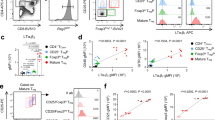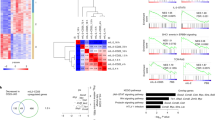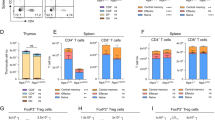Abstract
Regulatory T cells (Treg cells) expressing the forkhead family transcription factor Foxp3 are critical mediators of dominant immune tolerance to self. Most Treg cells constitutively express the high-affinity interleukin 2 (IL-2) receptor α-chain (CD25); however, the precise function of IL-2 in Treg cell biology has remained controversial. To directly assess the effect of IL-2 signaling on Treg cell development and function, we analyzed mice containing the Foxp3gfp knock-in allele that were genetically deficient in either IL-2 (Il2−/−) or CD25 (Il2ra−/−). We found that IL-2 signaling was dispensable for the induction of Foxp3 expression in thymocytes from these mice, which indicated that IL-2 signaling does not have a nonredundant function in the development of Treg cells. Unexpectedly, Il2−/− and Il2ra−/− Treg cells were fully able to suppress T cell proliferation in vitro. In contrast, Foxp3 was not expressed in thymocytes or peripheral T cells from Il2rg−/− mice. Gene expression analysis showed that IL-2 signaling was required for maintenance of the expression of genes involved in the regulation of cell growth and metabolism. Thus, IL-2 signaling seems to be critically required for maintaining the homeostasis and competitive fitness of Treg cells in vivo.
*Note: In the version of this article initially published, the GEO database accession number is missing. This should be the final subsection of Methods, as follows: Accession code. GEO: microarray data, GSE4179. The error has been corrected in the PDF version of the article.
This is a preview of subscription content, access via your institution
Access options
Subscribe to this journal
Receive 12 print issues and online access
$209.00 per year
only $17.42 per issue
Buy this article
- Purchase on SpringerLink
- Instant access to full article PDF
Prices may be subject to local taxes which are calculated during checkout







Similar content being viewed by others
Change history
10 March 2006
In the version of this article initially published, the GEO database accession number is missing. This should be the final subsection of Methods, as follows: Accession code. GEO: microarray data, GSE4179.The error has been corrected in the PDF version of the article.
References
Smith, K.A. Interleukin-2: inception, impact, and implications. Science 240, 1169–1176 (1988).
Sadlack, B. et al. Ulcerative colitis-like disease in mice with a disrupted interleukin-2 gene. Cell 75, 253–261 (1993).
Suzuki, H. et al. Deregulated T cell activation and autoimmunity in mice lacking interleukin-2 receptor β. Science 268, 1472–1476 (1995).
Willerford, D.M. et al. Interleukin-2 receptor α chain regulates the size and content of the peripheral lymphoid compartment. Immunity 3, 521–530 (1995).
Nelson, B.H. IL-2, regulatory T cells, and tolerance. J. Immunol. 172, 3983–3988 (2004).
Malek, T.R. & Bayer, A.L. Tolerance, not immunity, crucially depends on IL-2. Nat. Rev. Immunol. 4, 665–674 (2004).
Sakaguchi, S. Naturally arising CD4+ regulatory t cells for immunologic self-tolerance and negative control of immune responses. Annu. Rev. Immunol. 22, 531–562 (2004).
Malek, T.R., Yu, A., Vincek, V., Scibelli, P. & Kong, L. CD4 regulatory T cells prevent lethal autoimmunity in IL-2Rβ-deficient mice. Implications for the nonredundant function of IL-2. Immunity 17, 167–178 (2002).
Bayer, A.L., Yu, A., Adeegbe, D. & Malek, T.R. Essential role for interleukin-2 for CD4+CD25+ T regulatory cell development during the neonatal period. J. Exp. Med. 201, 769–777 (2005).
Furtado, G.C., Curotto de Lafaille, M.A., Kutchukhidze, N. & Lafaille, J.J. Interleukin 2 signaling is required for CD4+ regulatory T cell function. J. Exp. Med. 196, 851–857 (2002).
Almeida, A.R., Legrand, N., Papiernik, M. & Freitas, A.A. Homeostasis of peripheral CD4+ T cells: IL-2Rα and IL-2 shape a population of regulatory cells that controls CD4+ T cell numbers. J. Immunol. 169, 4850–4860 (2002).
Curotto de Lafaille, M.A., Lino, A.C., Kutchukhidze, N. & Lafaille, J.J. CD25-T cells generate CD25+Foxp3+ regulatory T cells by peripheral expansion. J. Immunol. 173, 7259–7268 (2004).
Setoguchi, R., Hori, S., Takahashi, T. & Sakaguchi, S. Homeostatic maintenance of natural Foxp3+CD25+CD4+ regulatory T cells by interleukin (IL)-2 and induction of autoimmune disease by IL-2 neutralization. J. Exp. Med. 201, 723–735 (2005).
de la Rosa, M., Rutz, S., Dorninger, H. & Scheffold, A. Interleukin-2 is essential for CD4+CD25+ regulatory T cell function. Eur. J. Immunol. 34, 2480–2488 (2004).
Thornton, A.M., Donovan, E.E., Piccirillo, C.A. & Shevach, E.M. Cutting edge: IL-2 is critically required for the in vitro activation of CD4+CD25+ T cell suppressor function. J. Immunol. 172, 6519–6523 (2004).
Fontenot, J.D. & Rudensky, A.Y. A well adapted regulatory contrivance: regulatory T cell development and the forkhead family transcription factor Foxp3. Nat. Immunol. 6, 331–337 (2005).
Fontenot, J.D. et al. Regulatory T cell lineage specification by the forkhead transcription factor Foxp3. Immunity 22, 329–341 (2005).
Godfrey, V.L., Wilkinson, J.E. & Russell, L.B. X-linked lymphoreticular disease in the scurfy (sf) mutant mouse. Am. J. Pathol. 138, 1379–1387 (1991).
Brunkow, M.E. et al. Disruption of a new forkhead/winged-helix protein, scurfin, results in the fatal lymphoproliferative disorder of the scurfy mouse. Nat. Genet. 27, 68–73 (2001).
Fontenot, J.D., Gavin, M.A. & Rudensky, A.Y. Foxp3 programs the development and function of CD4+CD25+ regulatory T cells. Nat. Immunol. 4, 330–336 (2003).
Ashburner, M. et al. Gene ontology: tool for the unification of biology. The Gene Ontology Consortium. Nat. Genet. 25, 25–29 (2000).
Gondek, D.C., Lu, L.F., Quezada, S.A., Sakaguchi, S. & Noelle, R.J. Cutting edge: contact-mediated suppression by CD4+CD25+ regulatory cells involves a granzyme B-dependent, perforin-independent mechanism. J. Immunol. 174, 1783–1786 (2005).
Grossman, W.J. et al. Human T regulatory cells can use the perforin pathway to cause autologous target cell death. Immunity 21, 589–601 (2004).
Read, S., Malmstrom, V. & Powrie, F. Cytotoxic T lymphocyte-associated antigen 4 plays an essential role in the function of CD25+CD4+ regulatory cells that control intestinal inflammation. J. Exp. Med. 192, 295–302 (2000).
Takahashi, T. et al. Immunologic self-tolerance maintained by CD25+CD4+ regulatory T cells constitutively expressing cytotoxic T lymphocyte-associated antigen 4. J. Exp. Med. 192, 303–310 (2000).
Paust, S., Lu, L., McCarty, N. & Cantor, H. Engagement of B7 on effector T cells by regulatory T cells prevents autoimmune disease. Proc. Natl. Acad. Sci. USA 101, 10398–10403 (2004).
Brusko, T.M., Wasserfall, C.H., Agarwal, A., Kapturczak, M.H. & Atkinson, M.A. An integral role for heme oxygenase-1 and carbon monoxide in maintaining peripheral tolerance by CD4+CD25+ regulatory T cells. J. Immunol. 174, 5181–5186 (2005).
Chan, C.W. et al. Soluble fibrinogen-like protein 2/fibroleukin exhibits immunosuppressive properties: suppressing T cell proliferation and inhibiting maturation of bone marrow-derived dendritic cells. J. Immunol. 170, 4036–4044 (2003).
Asseman, C., Mauze, S., Leach, M.W., Coffman, R.L. & Powrie, F. An essential role for interleukin 10 in the function of regulatory T cells that inhibit intestinal inflammation. J. Exp. Med. 190, 995–1004 (1999).
Malek, T.R., Porter, B.O., Codias, E.K., Scibelli, P. & Yu, A. Normal lymphoid homeostasis and lack of lethal autoimmunity in mice containing mature T cells with severely impaired IL-2 receptors. J. Immunol. 164, 2905–2914 (2000).
Almeida, A.R., Rocha, B., Freitas, A.A. & Tanchot, C. Homeostasis of T cell numbers: from thymus production to peripheral compartmentalization and the indexation of regulatory T cells. Semin. Immunol. 17, 239–249 (2005).
Piccirillo, C.A. et al. CD4+CD25+ regulatory T cells can mediate suppressor function in the absence of transforming growth factor β1 production and responsiveness. J. Exp. Med. 196, 237–246 (2002).
Fahlen, L. et al. T cells that cannot respond to TGF-β escape control by CD4+CD25+ regulatory T cells. J. Exp. Med. 201, 737–746 (2005).
Marie, J.C., Letterio, J.J., Gavin, M. & Rudensky, A.Y. TGF-β1 maintains suppressor function and Foxp3 expression in CD4+CD25+ regulatory T cells. J. Exp. Med. 201, 1061–1067 (2005).
Alexander, W.S. & Hilton, D.J. The role of suppressors of cytokine signaling (SOCS) proteins in regulation of the immune response. Annu. Rev. Immunol. 22, 503–529 (2004).
Antov, A., Yang, L., Vig, M., Baltimore, D. & Van Parijs, L. Essential role for STAT5 signaling in CD25+CD4+ regulatory T cell homeostasis and the maintenance of self-tolerance. J. Immunol. 171, 3435–3441 (2003).
Snow, J.W. et al. Loss of tolerance and autoimmunity affecting multiple organs in STAT5A/5B-deficient mice. J. Immunol. 171, 5042–5050 (2003).
Gentleman, R.C. et al. Bioconductor: open software development for computational biology and bioinformatics. Genome Biol. 5, R80 (2004).
Wu, Z., Irizarry, R., Gentleman, R.C., Murillo, F.M. & Spencer, F. A model based background adjustment for oligonucleotide expression arrays. Working Paper 1 (Johns Hopkins University, Department of Biostatistics Working Papers, http://www.bepress.com/jhubiostat/paper1, 2004).
Gentleman, R.C. in Proceedings of COMPSTAT 2004 Symposium (ed. Antoch, J.) 171–180 (Physica Verlag, Heidelberg, 2004).
Acknowledgements
We thank all members of the Rudensky lab for advice and discussions; and K. Forbush, L. Hsing, Y. Liang and L. Karpik for technical expertise and mouse colony management. Supported by National Institutes of Health (R01AI034206 to A.Y.R.) and Howard Hughes Medical Institute (A.Y.R.).
Author information
Authors and Affiliations
Corresponding authors
Ethics declarations
Competing interests
The authors declare no competing financial interests.
Supplementary information
Supplementary Fig. 1
Il2−/− and Il2ra−/− mice develop a less severe lymphoproliferative autoimmune syndrome than Foxp3− mice. (PDF 485 kb)
Supplementary Fig. 2
IL-2 neutralization reduces the percentage of Foxp3+ Treg cells and reduces amounts of CD25 and Foxp3 in Foxp3+ Treg cells. (PDF 623 kb)
Rights and permissions
About this article
Cite this article
Fontenot, J., Rasmussen, J., Gavin, M. et al. A function for interleukin 2 in Foxp3-expressing regulatory T cells. Nat Immunol 6, 1142–1151 (2005). https://doi.org/10.1038/ni1263
Received:
Accepted:
Published:
Issue Date:
DOI: https://doi.org/10.1038/ni1263
This article is cited by
-
Molecular Engineering of Interleukin-2 for Enhanced Therapeutic Activity in Autoimmune Diseases
BioDrugs (2024)
-
HIV specific Th1 responses are altered in Ugandans with HIV and Schistosoma mansoni coinfection
BMC Immunology (2023)
-
CD4+ and CD8+ regulatory T cell characterization in the rat using a unique transgenic Foxp3-EGFP model
BMC Biology (2023)
-
Regulatory T cells in autoimmune kidney diseases and transplantation
Nature Reviews Nephrology (2023)
-
Emerging principles of cytokine pharmacology and therapeutics
Nature Reviews Drug Discovery (2023)



